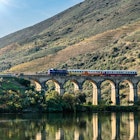
Slow travel: how to get from Seville to Lisbon by train (and a bus)

Oct 17, 2024 • 6 min read

When the time comes to leave stunning Seville, our writer opted for the scenic route home to Lisbon. Georgios Tsichlis/Shutterstock
Our slow travel series explores how you can take more mindful journeys by train, boat, bus or bike – with tips on how to reach your no-fly destination, and what to see and do along the way. Here, Austin Bush explains how he traveled from Seville, Spain, to Lisbon, Portugal, via land.
I had just spent two days in Seville bumping from tapas bar to tapas bar and it was possibly the most fun I’d ever had eating and drinking. But all good things must come to an end and I needed to get back home to Lisbon. There are direct flights between these cities, but I wanted to see this slice of southern Iberia up close.
- placement: fullWidth
- path: articles/in-content-top
- possible size: [970, 250], [970, 90], [728, 90], [300, 250], [320, 50], [1, 1],
- targeting:
{ "url": "seville-to-lisbon-by-train" }
The space and facilities afforded me by a train meant it was a natural choice over the bus. However, the lack of international train connections between Spain and Portugal meant my journey would be neither straightforward nor fast – but where's the fun in that?
Two trains, a bus, two travel hubs and nearly 15 hours of travel later, I arrived home. You could do it in less time but the joy of slow travel is about taking the time to explore and savor your surroundings. This is how I traveled from Seville to Lisbon by train.

Saying farewell to Seville
I kicked off my trip at 7:45am on a Sunday morning at Seville’s modern-feeling Santa Justa Train Station by boarding a nearly empty “medium distance” Renfe train to Huelva.
Spain’s Renfe trains are, in my experience, comfortable and efficient. I folded down the tray, plugged in my laptop and tethering with my phone (despite all the other conveniences, the wifi never seems to work), tackled some work.
Treated to a moving landscape of dry rolling hills, olive orchards and the occasional whitewashed village, I was reminded of parts of northern California. After just short of two hours, I arrived in the port city of Huelva.
First stop: Huelva
Unfortunately, there is no luggage storage facility at Huelva’s train or bus station, so I had to keep my bag with me. The town is just a ten-minute stroll from the station, where I had a very Spanish breakfast of chocolatey churros. From there, I walked around half a mile to Muelle de Riotinto, ostensibly Huelva’s main attraction – a two-level, sweeping 19th-century iron pier that juts out into the marshy inlet, overlooking both the city and the vast salt flats opposite.
- placement: fullWidth
- path: articles/in-content-middle
- possible size: [970, 250], [970, 90], [728, 90], [300, 250], [320, 50], [1, 1],
- targeting:
{ "url": "seville-to-lisbon-by-train" }

After an enjoyable walk along the shore, I returned to Huelva’s seemingly abandoned city center (it was, after all, Sunday morning). I wanted a taste of grilled cuttlefish – residents of Huelva are known as choqueros because of their fondness for choco, the local name for the cephalopod.
Sadly, Bar “Agmanir,” a recommended seafood restaurant that serves the dish, was closed. Eventually, I ended up at Bar Los Maestres, steps from the bus station, where I had my first taste of another popular local product, vinho de laranja – a sweetened, fortified wine seasoned with bitter orange peels.
Portugal is only 60km (37 miles) due west from Huelva, and though the Portuguese border town of Vila Real de Santo António has a train station, there are no tracks linking these places. This leg of the journey would happen aboard a bus to Faro, southern Portugal's travel hub.
Getting to Faro by bus
At 1:50pm, I boarded a packed bus at Huelva’s centrally-located bus station and spent the next hour and a half or so on a highway that passed orange orchards, dry hills, greenhouses and wooded areas with fluffy-looking trees. We crossed a bridge over the Guardiana River, unceremoniously moving from Spain into Portugal. I napped and listened to a podcast rather than try to work in a relatively tight space.
Upon arrival in Faro, I had around four hours before my next and final train. My early lunch felt like a distant memory so I hailed a taxi and made the short ride just outside of the city center for a late lunch. O Tintol is a grilled fish buffet – a concept that might only exist in Portugal – that includes sides that reflect southern Portuguese cuisine.

- placement: native
- path: articles/in-content-native
- possible size: [f, l],
- targeting:
{ "url": "seville-to-lisbon-by-train" }
After lunch, I took a cab back to central Faro. Once again, there were no luggage storage facilities at the train or bus station, so I used Nannybag for the first time – an app-based resource for luggage storage. I left my bag at a clothing shop near the train station and headed out to explore the town unburdened.
Faro’s historical center has an old wall, part of which can be climbed for views out over the marshy surroundings. The town has a few noteworthy churches – Igreja de Nossa Senhora do Carmo has a chapel lined with the bones of former monks – and its medieval city center is compact, charming and a delight to explore on foot.
After a couple of hours of wandering in the heat, I cooled off at one of several open-air cafes that line the Faro’s handsome marina, listening to fishermen chat and watching the boats pull in. Just offshore are five islands, which are connected to the city by frequent ferries, and it struck me that Faro could easily justify an overnight stay.
But I had a train to catch! At 6:15pm, I boarded a Comboios de Portugal (CP) train from Faro to Lisbon. It was close to sunset as we left, and as the light faded, the train sliced through the sparsely wooded hills of Portugal’s Algarve and southern Alentejo regions. I was able to plug in and work on this train as well and was beginning to enjoy this new mobile office.

Arriving home
After a little over three hours – nearly 15 hours after I’d boarded that train in Seville – we pulled into Lisbon’s Entrecampos Train Station. Although there had been no delays along the entire trip, I was exhausted. I grabbed a taxi and finally, was home.
How to make it happen
Tickets
I bought nearly all my tickets – Renfe, CP and FlixBus – in advance, using the companies’ respective apps. The train tickets – US$12.70 for Renfe, around US$26 for CP – were in line with prices I’d paid previously. The bus ticket, at nearly US$30, seemed expensive for an hour and 20-minute ride, but I had no other options.
Food and drink
Long-distance Renfe and CP trains have dining cars, but the options aren’t great – bags of snacks, simple sandwiches, beverages – and I also wanted to make local food part of my trip, so I factored in eating local food at transit points.
Facilities
There’s a lack of luggage storage facilities at smaller- and medium-sized Spanish and Portuguese bus and train stations, which is a problem for this type of travel. I’d use Nannybag – or a similar app service – again in the future.
- placement: fullWidth
- path: articles/bottom
- possible size: [970, 250], [970, 90], [728, 90], [300, 250], [320, 50], [1, 1],
- targeting:
{ "url": "seville-to-lisbon-by-train" }
Explore related stories



 Train TravelThe train journey from Lisbon to Madrid is a slow-travel showstopper
Train TravelThe train journey from Lisbon to Madrid is a slow-travel showstopperJun 14, 2024 • 5 min read


 Train TravelTake a train through the misty Celtic landscapes of northern Spain and Portugal
Train TravelTake a train through the misty Celtic landscapes of northern Spain and PortugalMay 5, 2023 • 7 min read
 Tips & Advice🌍 Help me LP! What is the one train trip that can include the best of Spain?
Tips & Advice🌍 Help me LP! What is the one train trip that can include the best of Spain?Feb 20, 2023 • 4 min read

 Budget TravelSpain adds long-distance buses to its free train and transit journeys
Budget TravelSpain adds long-distance buses to its free train and transit journeysDec 1, 2022 • 7 min read
